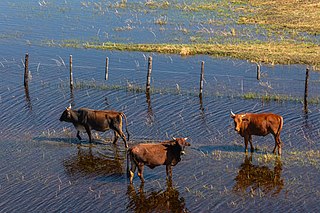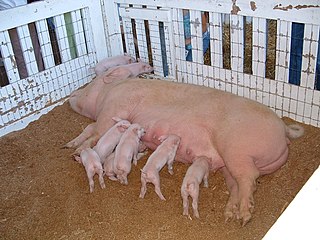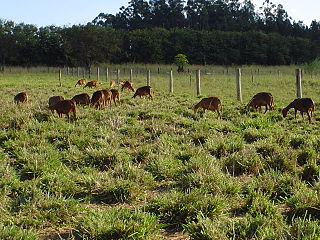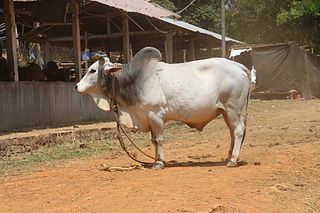The Foutanké or Fouta is a breed or type of light horse from Senegal, in West Africa. It results from the cross-breeding of a Fleuve stallion with an M'Bayar mare; its conformation is similar to that of the Fleuve. It is one of the four recognised Senegalese horse breeds – the others being the M'Bayar, the Fleuve and the M'Par – and is highly valued for horse-racing.

The Ukrainian Riding Horse or Ukrainian Saddle Horse is a modern Ukrainian breed of warmblood sport horse. Breeding began in the years after the Second World War at the stud farm of Dnipropetrovsk in central Ukraine – at that time in the USSR – and later expanded to three other state stud farms. It derives from cross-breeding of Hanoverian, Thoroughbred and Trakehner stallions with local mares or with Hungarian Furioso, Gidran Arab or Nonius mares. It incorporates the last bloodlines of the extinct Orlov-Rostopchin or Russian Saddle Horse. It was bred to compete in show jumping, three-day eventing and dressage, but is also suitable as a general riding horse.

The Tswana is an indigenous breed or group of breeds of beef cattle of Botswana. It is a Sanga type, similar to Barotse and Tuli. The coat colour may be solid red or black, red pied or – less frequently – black pied. It is also present in South Africa. Animals of this breed are well adapted to hot, dry environments and have a high level of tick and heat tolerance.

The American Yorkshire is an American breed of large domestic pig. It is the most numerous pig breed in the United States. It derives from pigs of the British Large White or Yorkshire breed imported from the United Kingdom or from Canada at various times from about 1830 to the mid-twentieth century.

The Yonaguni or Yonaguni uma (与那国馬) is a critically-endangered Japanese breed of small horse. It is native to Yonaguni Island, in the Yaeyama Islands in south-western Japan, close to Taiwan. It is one of eight horse breeds native to Japan.

The Dosanko (道産子), also known as the Hokkaido Horse and Hokkaido Pony, is one of the eight extant indigenous horse breeds of Japan, and the only one of the eight not critically endangered. It originated on the island of Hokkaido, in the far north of the country, and is found particularly along the Pacific (eastern) coast of the island. The people of Hokkaido may be nicknamed "Dosanko" after the horses.
The Yurino is a dual purpose cattle breed from the Russian Federation, particularly the Mari Republic.

The Misaki is a critically-endangered Japanese breed of small horse. It is one of eight Japanese native horse breeds, and lives as a feral horse in a natural setting in a designated National Monument on Cape Toi within the municipal boundaries of Kushima at the south end of Miyazaki Prefecture on the island of Kyūshū. The Misaki was made a Japanese National Natural Treasure in 1953.
The Taishū or Tsushima is a rare Japanese breed of small horse from Tsushima Island in the Korea Strait, in Nagasaki Prefecture, Japan.

The Irish Goat is a traditional Irish breed of domestic goat. It is a dual-purpose breed, used both for meat and for milk. It is an endangered breed and may survive only in feral populations. It is distinct from the feral Bilberry Goat of Waterford.

The Russian White Dairy or Russian White is a Russian breed of dairy goat. It derives from cross-breeding of the indigenous North Russian with imported Swiss Saanen goats; this began in about 1905. The Gorki derives from it, but is always horned, while the Russian White may be horned or polled. It has become a rare breed, numbering only a few thousand head.

Morada Nova is a Brazilian breed of domestic sheep. It originates in the state of Ceará, in Nordeste, the north-eastern region of Brazil, on the Atlantic coast.

The Malvi or Malavi, also known as Manthani or Mahadeopuri, is breed of zebu cattle from the Malwa plateau in western Madhya Pradesh, in central India. It is a good draught breed; the milk yield of the cows is low.
Western Sudan Pony is an exonym for a Sudanese breed or group of breeds or ecotypes of small horse or pony. These are distributed principally in southern Darfur and south-western Kordofan, extending into southern Chad, and are known generically as Gharbaui ("western") or by a variety of regional names including Darfur Pony and Kordofani.

The Marwari is an Indian breed of domestic sheep. It originates in, and is named for, the Marwar region of south-western Rajasthan, in the north-west of India. It is reared in the five principal districts of Marwar – Barmer, Jalore, Jodhpur, Nagaur and Pali – and also in some neighbouring districts of Rajasthan and Gujarat.

The Estonian Red is an Estonian breed of dairy cattle. It was developed in the second half of the nineteenth century from cross-breeding of local cattle with imported stock of the Angeln, Danish Red and North Slesvig Red breeds. The coat is red, but sometimes it varies from red-white to brown and rarely black.
The Shan Horse or Shan Myinn is a breed of small mountain horse or pony from the Shan Highland, in Shan State in eastern Myanmar (Burma). It was traditionally bred by the Shan people of that area. It is one of two horse breeds in Myanmar, the other being the Burmese Horse. It is similar to the Indian Manipuri, Spiti and Bhutia breeds of small horse or pony.
The Burmese Horse or Bama Myinn is a breed of horse from Myanmar (Burma). It is one of two horse breeds in Myanmar, the other being the Shan Horse.

The Red Brangus is an American breed of hybrid beef cattle, with both taurine and indicine genetic heritage. Development began in Texas in the 1940s. It is a colour variant of the Brangus, a hybrid of American Angus and Brahman cattle, and differs from it only in colour. There are two herd-books, one international and one American. For international registration the animal must be of 5/8 Angus and 3/8 Brahman descent; in the United States, it may be any mix of the two breeds, but registration is conditional on inspection.













